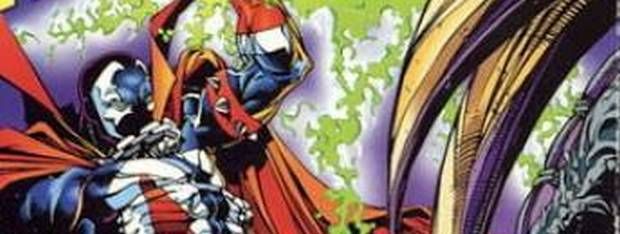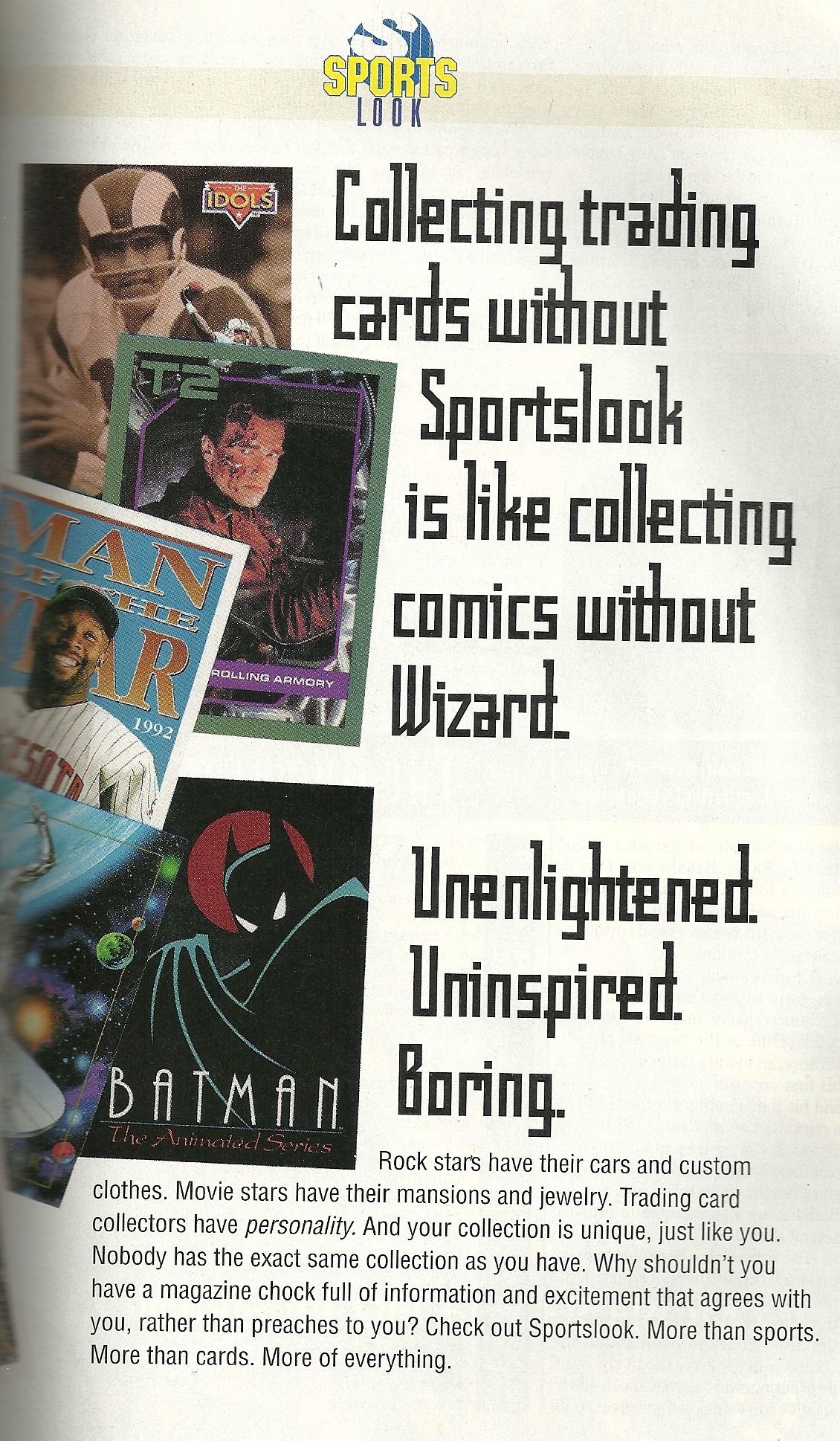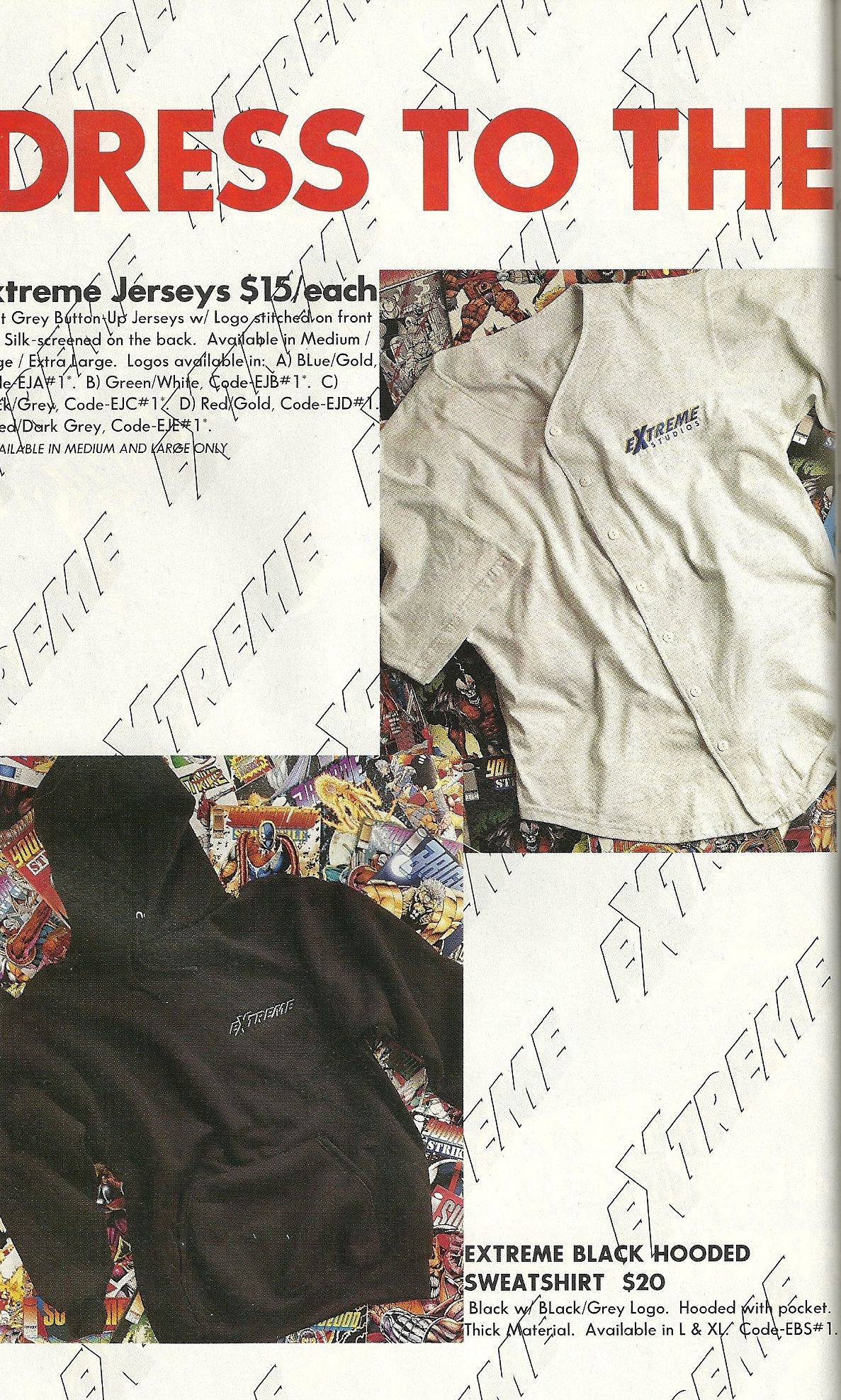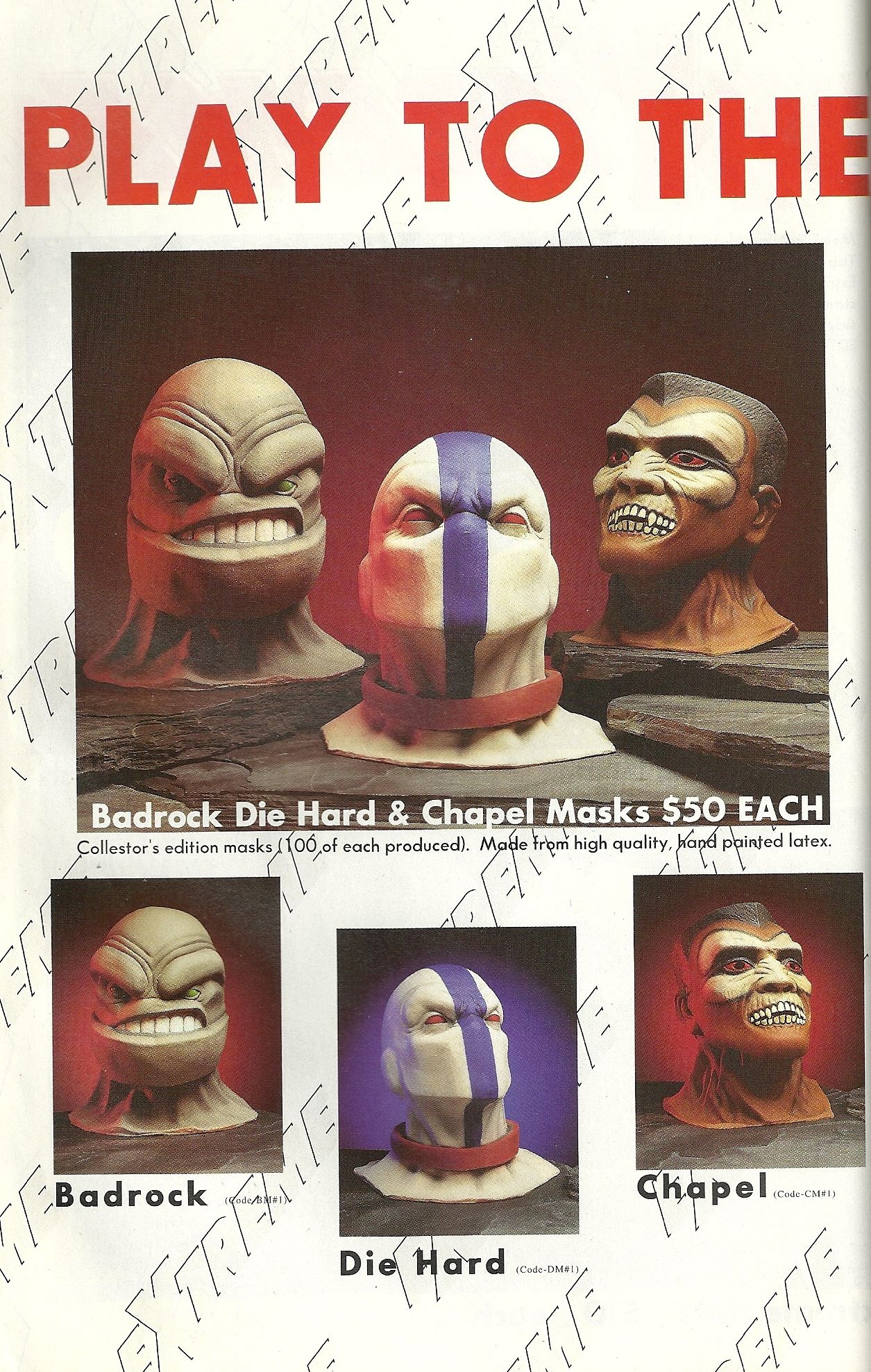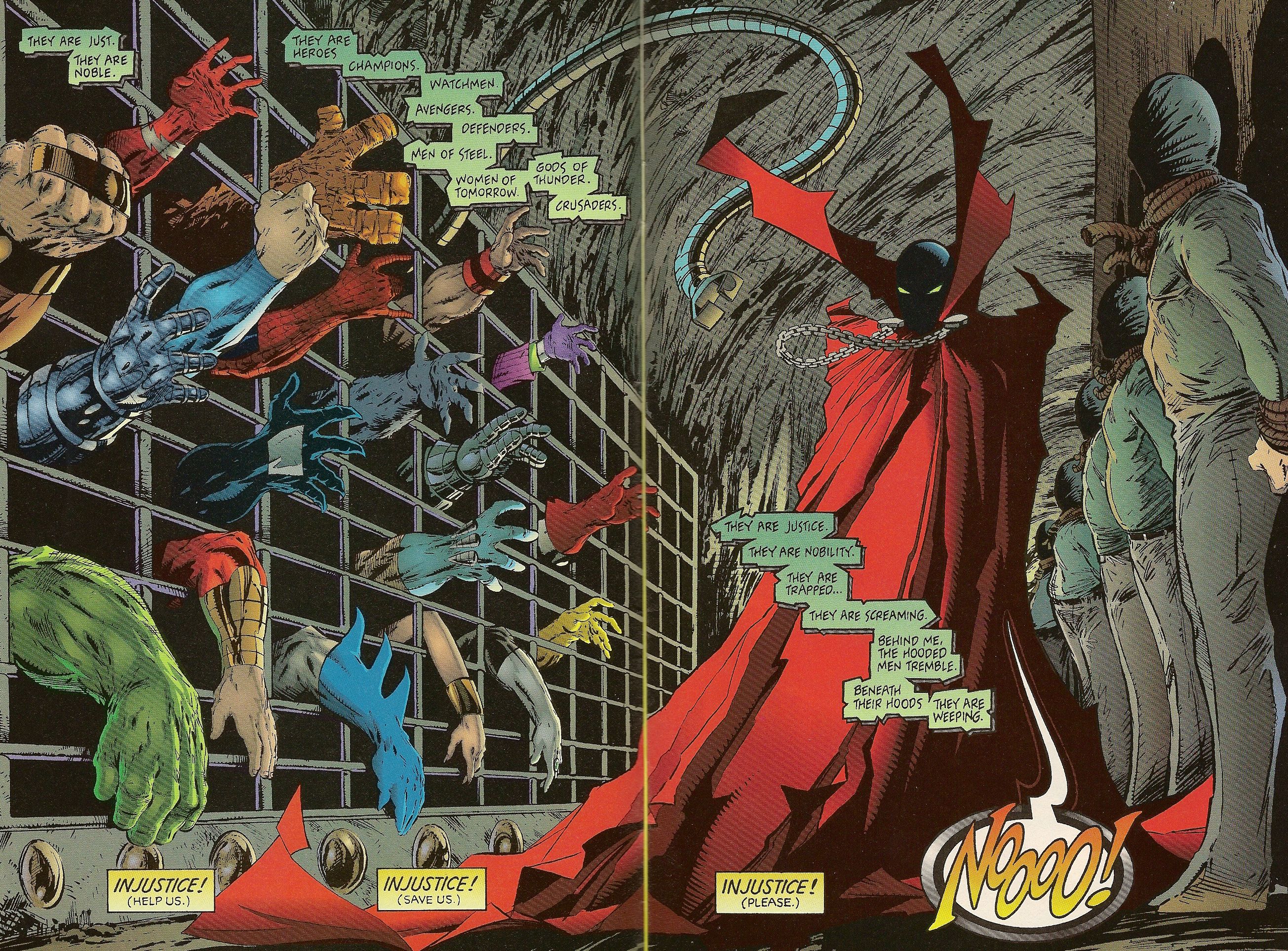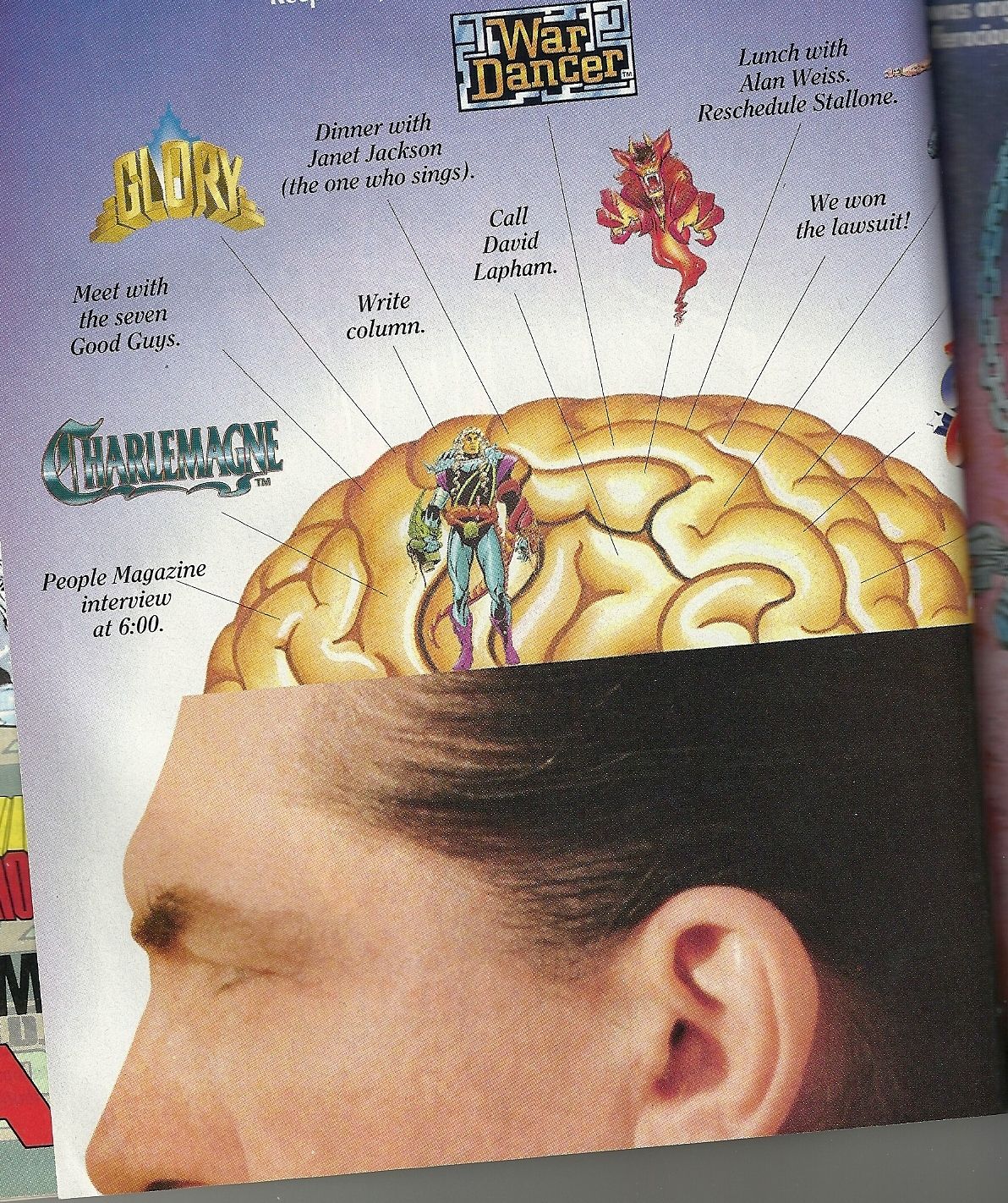How hard does Spawn hit that Soloflex? Can War Machine beat up the X-Men ? (No. Just stop this.) Are you ready for Youngblood’s animated debut? Prepare to relive the year 1993, repeatedly, in the Guide to the Guide to Comics.
I don’t think Wizard’s most ardent critics ever accused the magazine of being boring. Okay, I’m sure the “Maxim for Geeks” era was dull, but I’m talking about “classic” Wizard here. This issue, however, the big year-ender…it’s mind-numbing. That’s my impression after a cursory review, at least. Maybe I’ll change my mind after I peruse all two hundred ninety-six pages, but I’m not optimistic. (I’m not going to dignify that 300 pages claim…covers don’t count!)
Also, if you’re wondering if something’s wrong with Spawn’s abs on the cover, you’re not alone. There’s even a joke at their expense inside the magazine.
This month in Wizard, we have…
Features on what to expect in 1994, a look back on 1993, a list of the most influential players in comics, an examination of ongoing trends, and a retrospective on books cancelled in 1993. Also, pieces on recent cosmetic changes to established characters, “Necrology” -- a remembrance of creators who passed in 1993 (was this really the best name?), a prediction piece on the year 2003, and a look back on Philly Phest ’93, an early convention sponsored by the magazine.
The regular columns include Pat O’Neill’s “The Ed.”, Palmer’s Picks (this month’s entry, Eightball), Hollywood Beat (replacing Andy Mangels’ column), Bart Sears’ Brutes & Babes, Toying Around, Wizard of Cards, and Todd McFarlane’s E.G.O. Wizard also makes another attempt at a videogame column with Power Up!
The Departments include the standard mix of letters, fan art, trivia, opinion pieces, Top 10 lists, the Wizard Profile, and market information.
A Letter from our Publisher
Gareb Shamus recounts a conversation with a retailer who believes this era of comics should be known as the “Wizard Age of Comics” because the tone of the magazine fits the current mood of the industry. (Some might even argue that point to this day, but not as a compliment.) The rest of the two-page intro turns into an ad for Wizard’s new industry-related spinoff Entertainment Retailing, or just ER for short. ER is “an invaluable tool that will help your local store owner better his business,” and Shamus is encouraging Wizard readers to ask their local retailer to order the magazine. ER joins another sister Wizard magazine, Sportslook, which is dedicated to the trading card industry.
Magic Words
A pretty bland installment. No real controversy this issue, aside from a female reader asking other female fans to “lighten up” and stop griping about the portrayal of women in comics. The editorial response is only “Ten bucks says we gets lots of mail.” We also have a DC fan who questions why Wizard seems so biased towards Image, with the editor stating that the individual creators at Image are much easier to deal with than a corporate entity like DC. Finally, one fan tries to ignite a War Machine vs. X-Men feud, but that’s settled by Wizard bluntly asserting that the X-Men could in fact defeat War Machine.
Wizard News
The top story is the reunion of several EC Comics creators for new publisher Karl Art Publishing. Not quite sure why this ranked as the top story, but it’s nice to see Wizard paying some attention to artists like Al Williamson and John Severin. Other stories cover the continuing Marvel/Defiant lawsuit, Marvel UK’s reduction of 25 percent of its line (which Marvel swears aren’t cancellations, just books put on a later schedule), and the debut of…are you ready?...comics superstar Stephen Platt. Yes, Platt’s issues of Moon Knight are hot (his first issue selling for $20 in some stores) and Wizard predicts big things from this twenty-three year old prodigy.
In other news…
- Rob Liefeld’s Extreme Studios is sponsoring the Los Angeles Rams cheerleaders for the 1993-1994 season. Rob Liefeld has also announced a sabbatical from comics, following a hectic two years.
- Yet another new comics company, Dagger, is trying to find its place in the market.
- Gen 13 artist Jeffery Scott will now be credited as J. Scott Campbell (even though the ad on the very next page still has him as Jeff Scott).
Speak Up!
It’s a dry text piece asking fans their opinion on the year in comics. Isn’t the letter column better suited for this material?
The Ed.
It’s a dry text piece informing fans that first issues don’t always denote high quality, and maybe they should check out established titles like Thor or Swamp Thing.
Looking Ahead
It’s a dry text piece that offers previews of what the next year has in store for various publishers. Okay, this one was probably exciting at the time; I can remember eagerly anticipating all of these Wizard year-in-preview pieces.
Looking Back
It’s a dry text piece that recaps the previous year in comics. Aren’t these lookback features always filler? How many pages are truly necessary to recap things that have just happened? Of course, we’re not in 1993 now, so looking back on what Wizard deemed newsworthy might be worthwhile…
Year of the Publishers. 1992, Image’s birth year, signified the year of the creator. In 1993, “the empire stuck back” with major publishers releasing more superhero comics than ever before, and DC shedding its image as “the most conservative publisher in comics.” Image, now viewed by many as just as “corporate” as the Big Two, is facing increased scrutiny over missed deadlines. Wizard declares Image’s erratic shipping schedule turned Deathmate, “what could have been the summer’s most successful project, into a non-event.” While Marvel “seems to be waging its wars on Wall Street rather than in comic shops,” Valiant “more than any other publisher” had “guided the comic book industry into its current superhero-dominated shape.” I’d love to know Wizard’s reasoning on that one.
Creators of the Year. Wizard names Joe Quesada, Jeff Smith, Mike Allred, Neil Gaiman, Alan Moore, and Peter David as the creators of the year. (I had forgotten that Wizard’s staff were hardcore Peter David fanboys back in the day. Not that there’s anything wrong with that.) This seems to be a list of creators popular in Wizard’s offices; not necessarily reflective of what was selling in stores. The harsh truth is, far more fans were purchasing Howard Mackie comics than Mike Allred comics in 1993.
Year of Marketing Mayhem. The increased attention to comics from the mainstream media, in addition to gimmick covers and premium promotions, means comics were more “in your face in 1993 than ever before.” Wizard predicts fewer gimmick covers in 1994 because fans are getting sick of them; I don’t think they truly begin to die off until 1996, though.
Oh, the POG backlash begins here. “The briefest trend of the year had to be the POG craze,” which Wizard reports died as soon as the major card manufacturers entered the market. However…POGs aren’t dead yet, folks. POGs had a bizarre wave of popularity in the early ‘90s, beginning in Hawaii and spreading across the country; dying in one region just as another picked up on the fad. I have a trading card collectors magazine from 1995 with a cover story on the POG craze, questioning just when this phenomenon will peak.
The Year in Back Issues. Wizard again hypes Valiant as a big winner this year, along with Batman, Superman, X-Men, and Venom-specific Spider-Man issues.
The Drawing Board of the Pros
A deviation on the standard fan-art featured in Drawing Board -- this month features rejected Wizard covers by established pros. Erik Larsen’s Wolverine cover in issue #3 was originally going to star Lobo, for example. John Byrne has two rejected covers, one She-Hulk and the other Next Men, which seems odd given his popularity at the time. There’s also an amazing Deathlok cover painted by Joe Jusko that was shelved because the character’s popularity was waning. Bart Sears has even more covers for the magazine that never saw print. He’s also incorrectly credited by the editors for two rejected (and gross) cheesecake She-Hulk covers.
Movers & Shakers
Hey, did you order another dry text piece? Here’s one on the most influential people in comics, featuring everyone from Steve Geppi of Diamond to Clark Smith, Defiant’s sales and marketing manager.
Industry Roundtable
A dry text piece on “the future of the comic book marketplace.” A roundtable consisting of Malibu’s Tom Mason, Valiant’s Steve Massarsky, Jim Lee, Jim Shooter, and more answer questions ranging from the speculative market to the overlooked products of 1993. Everyone seems to agree that the speculators’ market had a negative influence and that it’s almost over. No one seems to realize just how badly the crash is going to be, though.
Ongoing Trends
Would you be stunned to learn that it’s another dry text piece? Okay, it’s actually a nice article by Pat O’Neill that asks retailers and creators their thoughts on what marketing trends will continue into 1994. But, honestly, hasn’t that ground been covered in three earlier articles this issue? This piece does have one of the few accurate predictions I’ve read so far -- retailer William A. Christensen foresees that the Vertigo approach will become more prevalent in mainstream superhero comics.
Lament for the Lost
Did you really want to read a dry text piece on the titles cancelled in 1993? Two notes on this article -- Marvel will later inform Wizard that William Shatner’s Tekworld is actually not cancelled in a later issue. The other is Mike Carlin’s somewhat infamous defense for cancelling Justice Society of America, featuring early work by Mike Parobeck: “Despite decent sales, DC felt the book was too ‘old-fashioned’ for today’s comic readers. DC editor Mike Carlin, in response to one of many letters sent by fans of the title, wrote ‘this is a commercial businesses, whether we like it or not…and we make decisions we feel will help strengthen the DC Universe. And not all of these decisions will be based on sales. Some will be based on vision and forward movement…’”
A Comic Odyssey
This was a major factor in my decision to review this issue. How could I resist Wizard’s attempt to predict the Year in Comics 2003 from the perspective of 1993? Here are the headlines:
McFarlane Buys Marvel
The CBNAC (Comic Book National Ad Council) Buys Time on Super Bowl
Voyager Communications (Valiant) Acquires Disney
Spider-Man Film to Laserdisc (but only in selected European markets)
Macaulay Culkin Signs on to Batman VI
Superman Divorces Lois
And the Comicfest 2003 report, which informs us super-group Nirvana was the opening act. The hot news is Steve Oliff’s Olyoptics purchasing Apple Computers, and “longtime fan favorite” Stephen Platt winning the award for Favorite Penciler, following his hit run on Legends of the Moon Knight.
Here’s the thing, though…virtually the entire piece is tongue-in-cheek. There’s no pretense Wizard’s looking into the future. (That Macaulay Culkin as Batman crack was kind of a giveaway.) It’s a gag piece, but it does hit on a few accurate predictions. Dave Sim does end Cerebus, as he always said, with issue #300. Many of the Image creators do return to Marvel; one even sells his characters to DC. And Rob Liefeld really doesn’t age between 1993 and 2003. And, arguably, not even from 2003 to 2015.
Philly Phest ’93
I’m guessing this was Wizard’s way of testing out the convention scene? It’s a wrap-up of the convention, which is notable as the location of the famous Peter David/Todd McFarlane debate, moderated by George Perez. The (first?) Wizard Fan Award Winners were also announced, with Todd McFarlane winning favorite artist, Peter David and Neil Gaiman tying for favorite writer, and Spawn picking up the favorite ongoing title award.
The Hollywood Beat
Rob Liefeld discusses the in-development Youngblood cartoon, being produced by Roustabout Productions, “a newly formed animation company made up of six veteran animation artists who have worked on big-name cartoons like Batman: The Animated Series, X-Men, Darkwing Duck, and others.” The preview reel they shot leaked online years ago, and I have to say it’s rather impressive. The '90s Spider-Man cartoon is also announced as a Fall debut on FOX, under the name The Spectacular Spider-Man.
Finally, there’s a feature on a new cable channel with a crazy premise -- the Cartoon Network actually airs cartoons seven days a week, twenty-four hours a day! I’m intrigued by the description of The Moxy Pirate Show, created by Liquid Television producers. Using 1993 technology, it will digitally create “real-time animation.” (A few minutes of it exist on Youtube.)
Comic Watch
Wizard speculates that Elektra’s first appearance might be valuable someday.
Picks from the Wizard’s Hat
Another issue, another Valiant comic as the top pick. This month it’s Bloodshot #0, by Kevin VanHook and Dick Giordano. With a Joe Quesada cover, of course. Wizard’s also thrilled Marc Silvestri is releasing Codename: StrykeForce #1 without the previously announced gimmick cover. The solicitation for X-Men #29 wasn’t ready, so Wizard just invents a joke plot. (X-Men #29 turns out to be the first issue to hint at Archangel and Psylocke’s relationship, as they go undercover at the Hellfire Club to investigate Shinobi Shaw.)
Top 100 - November 1993
Uncanny X-Men #308 is the highest ordered title this month. Spawn #18 is Number Two, and Cyberforce, Batman, and Superman round out the Top 10 (DC was barely in the Top 50 not too long ago, it seems).
Wizard Pop Quiz
Marketing research conducted by Wizard, in the guise of a fun survey. Two takeaways from this: 1. It’s packed with jokes, showcasing Wizard’s irreverent attitude, even when conducting such a dull task. 2. Wizard seems genuinely concerned with discovering which features fans like and dislike, an idea that also appears regularly in Gareb Shamus’ columns. You win a “wild” pair of shades if you participate in the survey, by the way.
Contests
Eight contests this issue. In the "Count Dem Spawn Hands!" contest, you name the hands from this two-page spread in Spawn #10 and win a complete set of signed Spawn comics.
Top 10 - December 1993
Remarkably, Daredevil #319 remains the top back issue of the month. Sliding in at Number Two is Stephen Platt’s debut on Moon Knight. Even the Fantastic Four make an appearance with issue #381, the “Death of Reed” issue. Eight of the Top Ten books are Marvels, which is a sharp deviation from Wizard’s previous claim that Marvel back issues are duds and only Image and Valiant are hot now. In fact, no Image or Valiant books are on the list this month.
Wizard Market Watch
A retrospective on the previous year (again), detailing the Death of Superman mania and the increased demand for trading cards, Valiant, and Ren & Stimpy back issues. In the price guide, the Peter David/Dale Keown issues of Incredible Hulk are hot, Bronze Age Iron Man issues are cooling, and Youngblood #1 is still listed at twelve dollars.
Wizard’s Ten Hottest Artists are…
- Todd McFarlane
- Joe Quesada
- Jim Lee
- Stephen Platt
- Frank Miller
- Marc Silvestri
- Erik Larsen
- Bart Sears
- Dale Keown
- Sam Kieth
Wizard’s Top Ten Hottest Writers are…
- Frank Miller
- Neil Gaiman
- Peter David
- Jim Shooter
- John Byrne
- Alan Moore
- Jim Starlin
- Matt Wagner
- Dan Jurgens
- Mike Grell
E G O (Everyone’s Got Opinions)
In the spirit of brotherly love, Todd McFarlane reflects on positive events in the previous year in comics, including the birth of Dark Horse’s Legend imprint, Topps making comics with Jack Kirby, and Marvel keeping the Spider-Man and X-Men lines relevant even after losing so many of its popular creators.
So, what did we learn today?
Money Quotes:
- “Don’t expect it to be deep or psychological. It’ll just be something that, when you read it, will be really cool.” - Todd McFarlane on the upcoming Spawn/Batman crossover. (Wizard News)
- “I feel that the speculative market on comic books is beginning its last gasp of the trading card-foil embossed-look at me-I glow in the dark-scratch me-feel me-smell me-make the buyer feel like he or she is getting a limited edition-send your kid through medical school era of raccoon marketing…” - Beau Smith (Industry Roundtable)
- “I for one welcome the lower numbers; they show a more discriminating taste. For a while, they were ordering anything with the Image banner at really high numbers, and it was perplexing me…I was wondering, ‘What’s going on here?’” - Jim Lee (Industry Roundtable)
- “(I would have) ordered less comics.” - Retailer Gary Colabuono on what he would’ve done differently in 1993. (Industry Roundtable)
- “Batman, Iron Man, they can’t get on the Arsenio show. They can’t get on Jay Leno.” - Mr. T, featured as one of Wizard’s “Best Quotes of 1993.”
- “Writing X-Factor had started to be like making love wearing a Kevlar condom. You’re going through the motions, but a lot of the feelings are missing.” Peter David, another one of Wizard’s “Best Quotes of 1993.”
Nope:
- ClanDestine is promoted as a four-issue Marvel UK comic shipping in January; it’s delayed for around six months and eventually released as an ongoing mainstream Marvel series. The ad’s tagline is also odd, declaring that old ‘60s superheroes should’ve stayed dead. I guess this is a reference to Superman’s recent resurrection, but Superman certainly predates the ‘60s! And Alan Davis is surely someone unlikely to advocate throwing out the established heroes.
- Stephen Platt never takes over Cable, instead leaving Marvel to pencil Prophet for Rob Liefeld.
- Turner Entertainment’s attempts to turn Stan Saki’s Space Usagi into a cartoon never materialized.
- Fabian Nicieza and an unnamed artist do not produce the second Deadpool miniseries. It’s by Mark Waid and Ian Churchill.
- The Spumco comic book John Kricfalusi produced for Marvel was shelved, as I recall. Looking online, it seems Dark Horse picked up the series, but Marvel did end up publishing the final issue, years later. There might be a Comic Book Legend in here...
- Spawn #19 is not the story of Spawn meeting the Freak. That issue is delayed until #37, and the original cover didn’t run until a few years ago! Spawn #20 is also not told from the devil’s perspective, but this does sound like an idea later used in Spawn #26. Also, Spawn #19 and Spawn #20 are delayed several months due to a political statement McFarlane wanted to make against Diamond’s punishment for late books. You can learn more by following the links to my old reviews of these issues.
- The Youngblood cartoon does not debut in the 1994-1995 season, but CBS did come very close to picking the series up.
Talkin’ ‘Bout Gen 13 (Relentlessly): Nothing much this issue, but the Next Issue teaser has promo art by a young Jeffery Scott that is, well, pretty rough. Campbell’s rapid development as an artist was truly remarkable.
This Ain't HuffPo: Wizard’s mock solicit for X-Men #29 has Bishop losing his testosterone and becoming a Ru Paul backup singer.
Pathological Scatological: Wizard jokes this issue that Wolverine’s unique hairstyle is kept up with his snot, questions whether or not characters with green hair like Polaris have it somewhere else, and remarks Yoda’s septic tank must be backing up in the Super Empire Strikes Back game. There’s also a caption joke in the trading card section that’s based on the assumption the Penguin can’t relieve himself...I guess because he’s so fat? (The caption jokes in the Card Price Guide are often terrible.)
Cheap and Stupid and Trashy?: I can’t say it’s any of those things, but unfortunately, this issue turned out to be as tedious as I feared it would be. How’s about commissioning one end-of-the-year piece instead of twenty, Wizard?
If you have any suggestions for future entries, let me know in the comments section. Until next week, you can find me at Not Blog X and on Twitter.

